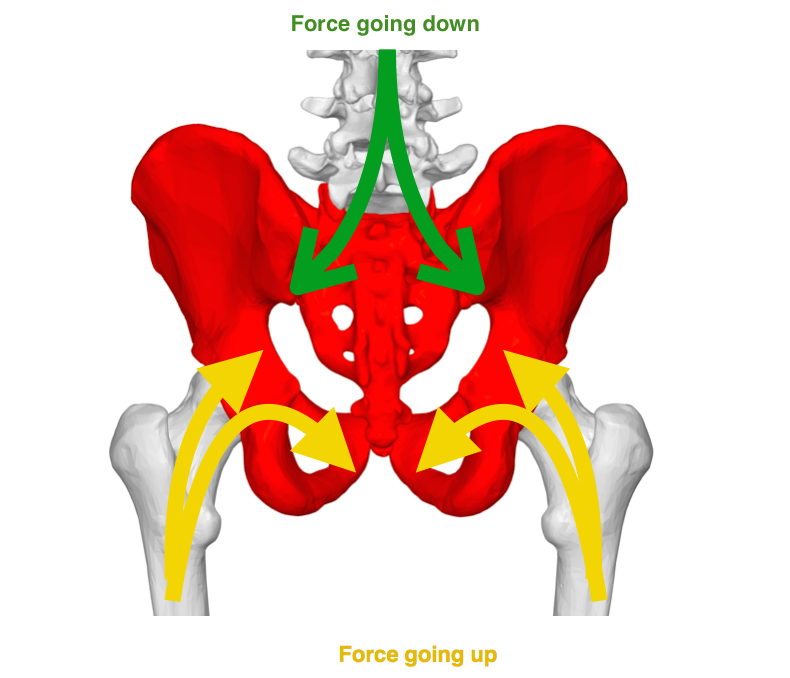In preparation for my next blog on the functional assessment of the sacroiliac joint (SIJ), I though it might be useful to explain the basics (as I see them) about these fascinating little joints. As I suffered (and occasionally still do suffer) with SIJ pain, I have discovered it is an area of the human body that is shrouded in mystery. After meeting and studying with the lovely Diane Lee I feel, I finally have a model that I can use to assess this pair of joints and I must say on a personal level my back has never felt more brilliant!
Anatomy
Before opening the Pandora’s box that is the sacroiliac joint, lets start with the basics. What is a joint? A joint is the space between 2 bones. If you think about the hip joint, the two bones involved are the thigh bone (femur) and the pelvis. In this example the shape of the joint (a ball and socket) allows movement to occur in a big three dimensional circle and any combination of movement within.
The sacroiliac joint is a slightly different beast and to understand it we need to first look at the pelvis. The pelvis is made up of two halves,each half made up of 3 fused bones called the ilium, ischium and pubis. The front of the 2 pelvic bones are joined together at the pubic symphysis by strong ligaments (if you’ve ever been pregnant you might have cursed this joint) and at the back we have the junction that joins the sacrum at the bottom of the spine into the pelvis – the infamous sacroiliac joints.
What are the roles of the sacroiliac joints
The roles of the sacroiliac joints are to channel the force of the ground coming up through our legs and the weight of our body coming down through our spine, as well as to stabilise the junction between the pelvis and spine. The weight of our upper body and whatever we happen to be carrying passes down the spine until it comes to the junction of the sacroiliac joints where it now has the option of being shared, via the pelvis, down our 2 legs. The sacroiliac joints transmit this force and dampens it on the way through like a pair of mini shock absorbers. This journey can also be reversed as seen when our foot hits the ground and force is passed up.
How do they it do it?
For these joints to do their job effectively they need incredible strength, and this begins with the architecture of the bones themselves. The 2 wings of the ilia create a beautiful funnel into which the wedge shaped sacrum nestles snuggly, while the rough joint surface of the bones enable them to lock into place like the cogs of a clock. A motor way of ligaments and muscles then surround the joints to fortify their strength during the critical moments of movement when they are exposed to the most load. There has been much wonderful work recently that has looked at how muscles are set up to work as fascial slings, enabling muscular contraction to create force closure and thus stability. We will look at some of these patterns in the following vlog.
So do the sacroiliac joints move?
If you ever want to see fireworks outside of Guy Fawkes night, drop this question into a room full of therapists, light the touch paper and watch from a safe distance.
In a nutshell the answer is yes. There is no way near the same range of motion as a hip joint and as we age this movement is reported to become even less (until in some it can eventually even fuse) however without it we have bit of a problem. To figure out why the sacroiliac joints must move we need to go back to the anatomy of the pelvis and realise how it has evolved to function more efficiently. If our pelvis did not need to move it would be infinitely stronger if it was made up of one whole bone instead of two halves with a pubic symphysis at the front and a sacrum wedged between the two ilia. To understand why it is as it is, I want you to stand up and place your fingers just under the 2 knobbly bits on the front of your hips called the ASISs (anterior superior iliac spines of the pelvis) and cup the rest of the pelvis in a c-shape with your palms. With your hands in place now go for a little walk around the room and notice how these bones start to rock up and down with each step you take. Now repeat the walk and try to do so without letting the pelvis move at all. You should have found the latter near impossible (unless you were wearing a very tight pencil skirt) and instead noticed that your pelvis nods in opposition as your pelvic ring rotates, drops and hikes in response to the pull of your lower limbs as you move. If your pelvis was in fact solid it would have to shatter with each step you took!
The problem we face is that because the motion is so small and we can have both too much or not enough of it, we need an assessment that allows us to know when and where to start treating …
…and with that little teaser I will leave you on the edge of your seat until the next functional assessment video.


